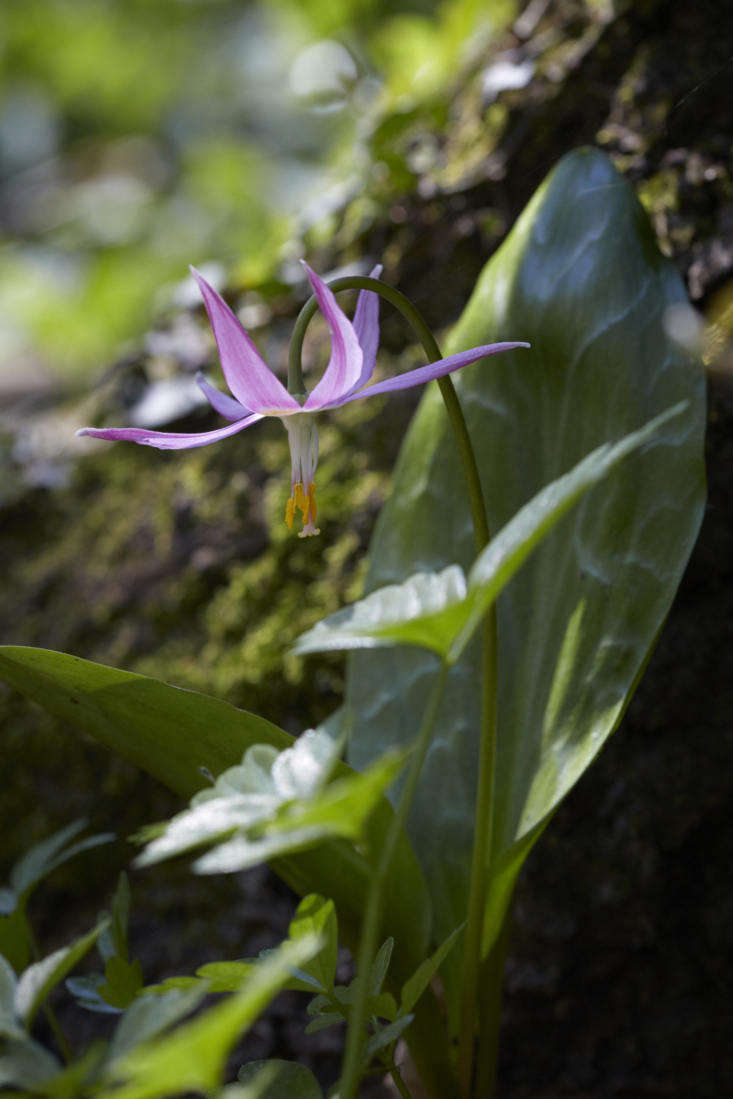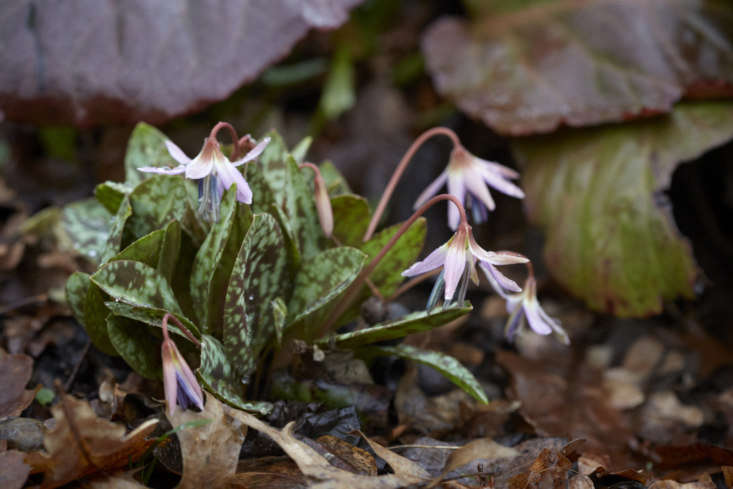Trout Lily, Erythronium
Erythronium is an underused yet extremely pretty messenger of spring. Tolerating rustic nicknames such as trout lily, adder’s tongue, or dog’s-tooth violet, this flowering bulb is a more sophisticated thing altogether.
Whatever you call these spring jewels, they are problem solvers. Despite their looks, they don’t need the prominence of a flower bed; instead, encourage Erythronium to spread under a deciduous tree, where grass is reluctant to grow. In winter and spring they appreciate moisture, while in summer, a tree’s canopy keeps them shaded.
Photography by Britt Willoughby Dyer, for Gardenista.

Most varieties are North American woodland dwellers. Their European and Asian equivalent is the dens-canis or dog’s tooth, named after the curved and pointed corms. Readily available Erythronium ‘Pagoda’ is a vigorous American hybrid, standing taller than the wild specimens (growing to about 18 inches high).

Seeing one or two erythroniums among other spring bulbs is the usual thing; they don’t spread around very easily on their own, the exception generally being E. revolutum. With ‘Pagoda’ and E. dens-canis, plants should be left a few years to bulk up, before being lifted up and their corms divided. With attention, they will bulk up.

American erythroniums bear the most resemblance to other members of their extended family, Liliaceae (which also includes tulips). Reflexing petals recall martagon lily, this being an earlier, daintier version, while the wide leaves of erythronium are a shiny, mottled, and arguably more interesting take on tulip foliage.

Erythroniums can be variable in their petal markings and in the the degree of marbling of the leaves.

Erythronium revolutum naturalizes happily in the right conditions, like Crocus tommasianus the month before. Also like croci, the intensity of erythronium’s colors can require a little thought. They grow well with small daffodils (such as the petticoat variety, Narcissus bulbocodium) but do you really want a wave of bright pink and bright yellow? The key is in the scale: anything that pops up in turf—in March or April—that is small, such as wood anemones, cowslips, and lungwort, adds to the jollity of the scene, with dandelions welcome too. Large daffodils (like the ones on roadsides in England) are out.

Besides the pure color of spring’s flowers, foliage shines out at this time of year. Glossy, marbled erythronium leaves join the gloss of arum lily and Bergenia, contrasting with the matte filigree shapes of Dicentra and Anemone.


Cheat Sheet
- Flowering in late March and April, Erythronium is a natural and elegant partner to dark red Trillium, both in flower and leaf.
- Erythronium dens-canis, the dog’s-tooth violet, is native to Europe and China, while the other varieties commonly called trout lily or adder’s tongue are American.
- They mingle well with other spring meadow flowers and woodlanders, as specimens or nurtured crowds of floating, reflexed petals, in pink, mauve, yellow, or white.

Keep It Alive
• Erythronium dens-canis is hardy to USDA zones 3 to 7, whereas the E. americanum can tolerate the higher temperatures of zone 9b.
• Corms that arrive in mail order packages tend to be dried out, so buy a few in pots to get them going.
• Erythronium revolutum naturalizes happily in sparse turf, while Erythronium dens-canis can be dug up and divided after flowering, every few years.
• Woods and mountains are the native conditions to try to replicate, with fallen leaves turning into a rich humus, ideally, preventing the corms from becoming too dry.

Read more tips in Trout Lily: A Field Guide to Planting, Care & Design in our curated design guides to Bulbs & Tubers 101. See more ways to encourage colorful spring-flowering bulbs:
- Garden Design 101: Crocus, a Perfect Excuse for Color
- Wood Anemones: A Field Guide to Planting, Care & Design
- Architects’ Secrets: The Best Plants to Grow Beneath a Tree









Have a Question or Comment About This Post?
Join the conversation